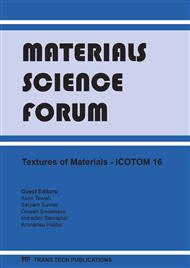p.876
p.880
p.884
p.888
p.892
p.896
p.900
p.904
p.908
Evolution of Texture and Microstructure during Cold Rolling and Annealing of Fe-14Mn-6Si-9Cr-5Ni Shape Memory Alloy
Abstract:
Evolution Texture and microstructure has been investigated in a Fe-14Mn-6Si-9Cr-5Ni shape memory alloy during cold rolling and annealing. The starting solution-annealed material show a nearly random texture with microstructure composed of equi-axed austenite grains with some e martensite plates inside. Cold rolling induces a strong alloy type texture with Brass {011}<211> and Goss {011}<100> as major components. Annealing of the cold deformed material produces a nearly random texture. The microstructural investigation reveals that with increasing cold deformation the amount of stress induced e and a’ martensite volume fraction increases. The electron back scattered diffraction (EBSD) phase mapping shows that reversion of the e martensite starts only after commencement of recrystallization.
Info:
Periodical:
Pages:
892-895
Citation:
Online since:
December 2011
Price:
Сopyright:
© 2012 Trans Tech Publications Ltd. All Rights Reserved
Share:
Citation:


